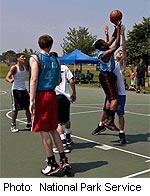
WEDNESDAY, Jan. 8, 2014 (HealthDay News) — Although U.S. health experts recommend that kids engage in moderate-to-vigorous physical activity for at least 60 minutes daily, only one in four actually does so, according to a report released Wednesday.
However, about 60 percent of boys surveyed and 49 percent of girls did get in an hour five days or more each week, according to study researcher Tala Fakhouri.
Overall, she said, the researchers aren’t happy with the findings. “This is not enough. I think we can do better,” said Fakhouri, an epidemiologist with the National Center for Health Statistics (NCHS), part of the U.S. Centers for Disease Control and Prevention.
Another expert agreed. “Only one-quarter of adolescents getting one hour of activity every day is a low percentage,” said James Sallis, a distinguished professor of family and preventive medicine at the University of California, San Diego. “This means most teens are at risk for poor physical and mental health due to their inactive lifestyles. The data was obtained by self-report, which is notorious for overestimating.”
The new findings come at a time when child obesity is a growing concern and there’s a nationwide push to get kids more active.
The CDC researchers used 2012 data from the combined National Health and Nutrition Examination Survey (NHANES) and the NHANES National Youth Fitness Survey. The findings are published in the January issue of the NCHS Data Brief.
Kids covered in the report were aged 12 to 15. Boys were more likely than girls to meet the 60 minutes a day recommendation, with 27 percent of them doing so. Among girls, 22.5 percent met the requirement.
The researchers also found that nearly 8 percent of kids did not get in any moderate-to-vigorous physical activity for an hour on any day of the week.
Boys who exercised favored basketball, followed by running, football, bike riding and walking. Girls favored running, then walking, basketball, dancing and bike riding.
The boys and girls who were obese were less likely to be active than the youth of normal weight. It’s not clear exactly why that is, the researchers said. While some think obesity is due to the inactivity, at least partially, others suggest the inactivity is due to the obesity.
The new data echo some findings from a previous CDC study, Fakhouri said. “In data from 2011, [researchers] found 29 percent of high school children met the physical activity guideline of one hour a day, every day,” she said.
Moderate-to-vigorous activity is exercise such as walking or jogging, done intensely enough so that ”you can talk but you cannot sing,” she said.
Sallis said the finding that boys prefer basketball is a positive one “because it is such an active game.” However, he added, football, also popular among boys, “likely provides limited activity because they spend most of the time waiting for the next play.”
In his study published 2011 in the Archives of Pediatric and Adolescent Medicine, Sallis and others found that youth practicing on soccer, baseball and softball teams actually got in only about 45 minutes of moderate-to-vigorous activity, on average, on practice days.
Good news from the new CDC study, Sallis said, was that “all of the girls’ top five activities provide continuous movement.”
Some research has found that children who get regular physical activity carry the habit into adult years, Fakhouri said.
Parents can encourage more physical activity among their children by doing some exercise with them, Fakhouri said, and letting them know the one hour can be cumulative over the day. “Even though the one hour a day may seem overwhelming, you can achieve these goals doing small things — taking a family walk after dinner, dancing and playing basketball,” she said.
Parents can also obtain much information from the Let’s Move! initiative developed by First Lady Michelle Obama, she added.
For his part, Sallis said, “I would ask parents to resolve to make sure their children get physical activity every day, and they can’t count on schools to provide all the activity teens need.”
He suggested signing children up for after-school sports, dance and martial arts classes. However, the programs vary in how much activity is involved. “And the only way for parents to know is to go and observe,” he said.
More information
To learn more about kids and physical activity, visit Let’s Move!
Copyright © 2025 HealthDay. All rights reserved.

